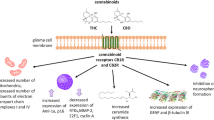Abstract
Astrocytomas, the most prevalent primary brain tumors, can be divided by histology and malignancy levels into four following types: pilocytic astrocytoma (grade I), diffuse fibrillary astrocytoma (grade II), anaplastic astrocytoma (grade III), and glioblastoma multiforme (grade IV). For high grade astrocytomas (grade III and grade IV), blood vessels formation is considered as the most important property. The distribution of cannabinoid receptors type 1 (CB1) and cannabinoid receptor type 2 (CB2) in blood vessels and tumor tissue of astrocytoma is still controversial. Asrocytoma tissues were collected from 45 patients under the condition of tumor-related neurosurgical operation. The expression of CB1 and CB2 receptors was assessed using immunofluorescence, quantitative real-time RT-PCR and western blotting. The results indicated an increased expression of CB1 receptors in tumor tissue. There was a significant difference in the mount of CB2 receptors in blood vessels. More was observed in the grade III and glioblastoma (grade IV) than astrocytoma of grade II and control. This study suggested that, the expression increase of cannabinoid receptors is an index for astrocytoma malignancy and can be targeted as a therapeutic approach for the inhibition of astrocytoma growth among patients.




Similar content being viewed by others
References
Folkman J (2007) Angiogenesis: an organizing principle for drug discovery? Nat Rev Drug Discov 6:273–286
Massi P, Vaccani A, Ceruti S et al (2004) Antitumor effects of cannabidiol, a nonpsychoactive cannabinoid, on human glioma cell lines. J Pharmacol Exp Ther 308:838–845
Howlett AC, Barth F, Bonner TI et al (2002) International Union of Pharmacology. XXVII. Classification of cannabinoid receptors. Pharmacol Rev 54:161–202
Fernandez-Ruiz J, Romero J, Velasco G et al (2007) Cannabinoid CB2 receptor: a new target for controlling neural cell survival? Trends Pharmacol Sci 28:83–92
Wu X, Han L, Zhang X, Li L et al (2012) Alteration of endocannabinoid system in human gliomas. J Neurochem 120:842–849
Ellert-Miklaszewska A, Ciechomska I, Kaminska B (2013) Cannabinoid signaling in glioma cells. Adv Exp Med Biol 986:209–220
Sanchez C, de Ceballos ML, Gómez del Pulgar T et al (2001) Inhibition of glioma growth in vivo by selective activation of the CB2 cannabinoid receptor. Cancer Res 61:5784–5789
Guzmán M, Galve-Roperh I, Sánchez C (2001) Ceramide: a new second messenger of cannabinoid action. Trends Pharmacol Sci 22:19–22
Gómez del Pulgar T, Velasco G, Sánchez C et al (2002) De novosynthesized ceramide is involved in cannabinoid-induced apoptosis. Biochem J 363:183–188
Sadri S, Bahrami F, Khazaei M, Hashemi M, Asgari AR (2010) The cannabinoid receptor agonist WIN55,212–2 protects differentiated PC12 cells from organophosphorus-induced apoptosis. Int J Toxicol 29:201–208
Recht LD, Salmonsen R, Rosetti R et al (2001) Antitumor effects of ajulemic acid (CT3), a synthetic non-psychoactive cannabinoid. Biochem Pharmacol 62:755–763
Cudaback E, Marrs W, Moeller T et al (2010) The expression level of CB1 and CB2 receptors determines their efficacy at inducing apoptosis in astrocytomas. PLoS ONE 5:e8702
Lemée JM, Com E, Clavreul A et al (2013) Proteomic analysis of glioblastomas: what is the best brain control sample? J Proteom 24:165–173
Held-Feindt J, Dörner L, Sahan G, Mehdorn HM, Mentlein R (2006) Cannabinoid receptors in human astroglial tumors. J Neurochem 98:886–893
De Jesús ML, Hostalot C, Garibi JM, Sallés J, Meana JJ, Callado LF (2010) Opposite changes in cannabinoid CB1 and CB2 receptor expression in human gliomas. Neurochem Int 56:829–833
Schleya M, Ständerb S, Kernerd J et al (2009) Predominant CB2 receptor expression in endothelial cells of glioblastoma in humans. Brain Res Bull 79:333–337
Benito C, Tolón RM, Pazos MR, Núñez E, Castillo AI, Romero J (2008) Cannabinoid CB2 receptors in human brain inflammation. Br J Pharmacol 153:277–285
Nunez E, Benito C, Pazos MR, Barbachano A, Fajardo O, Gonzalez S, Tolon RM, Romero J (2004) Cannabinoid CB2 receptors are expressed by perivascular microglial cells in the human brain: an immunohistochemical study. Synapse 53:208–213
Ellert-Miklaszewska A, Grajkowska W, Gabrusiewicz K, Kaminska B, Konarska L (2007) Distinctive pattern of cannabinoid receptor type II (CB2) expression in adult and pediatric brain tumors. Brain Res 1137:161–169
Blazquez C, Gonzalez-Feria L, Alvarez L et al (2004) Cannabinoids inhibit the vascular endothelial growth factor pathway in gliomas. Cancer Res 64:5617–5623
Zhu LX, Sharma S, Stolina M et al (2000) Δ9-Tetrahydrocannabinol inhibits antitumor immunity by a CB2 receptor-mediated, cytokine dependent pathway. J Immunol 165:373–380
Torres S, Lorente M, Rodríguez-Fornés F et al (2011) A combined preclinical therapy of cannabinoids and temozolomide against glioma. Mol Cancer Ther 10:90–103
Acknowledgements
This study was funded by the functional neurosurgery research center, Shahid Beheshti University of medical sciences (Grant Number: 14137).
Author information
Authors and Affiliations
Corresponding author
Ethics declarations
Conflict of interest
The authors declare that they have no conflict of interest.
Ethical approval
All procedures performed in study according to the Ethical Commission of the Shahid Beheshti University of Medical Sciences. Ethical code of study is IR.SBMU.RETECH.REC.1397.272.
Informed consent
Informed consent was obtained from all individual participants included in the study.
Additional information
Publisher's Note
Springer Nature remains neutral with regard to jurisdictional claims in published maps and institutional affiliations.
Rights and permissions
About this article
Cite this article
Hashemi, M., Bashi, S. & Zali, A. The expression level of cannabinoid receptors type 1 and 2 in the different types of astrocytomas. Mol Biol Rep 47, 5461–5467 (2020). https://doi.org/10.1007/s11033-020-05636-8
Received:
Accepted:
Published:
Issue Date:
DOI: https://doi.org/10.1007/s11033-020-05636-8




